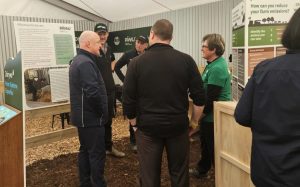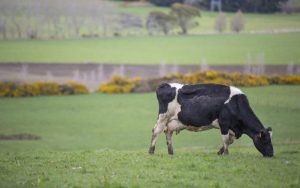
New Zealand’s groundbreaking tax on livestock emissions would cost a typical big dairy farm in the country more than €11,000 per year, or about €34 per hectare.
The calculation for a 330-hectare dairy operation assumed the farm would emit 2,600 kg per hectare per year of methane, priced at €0.067 per kg. This 780,000kg emission would cost the farm more than €52,000 in levies.
The farm would emit 910kg/hectares in carbon dioxide equivalent per year of nitrous oxide, and 965kg of carbon dioxide. These would be priced at €2.58 per tonne. The farm’s total 662.5 tonnes per year emissions of these gases would cost it €1,454 in emissions.
The proposed livestock emissions levy includes an incentive discount for approved emission reduction actions and technologies. For example, if the 330-hectare dairy farm switched its breeding policy to methane-reducing genetics (expected to cost €9.12 per AI straw over and above currently used AI straws), it would get credit for a 20% reduction in methane from the cows. That would cut the levy payment by nearly €18,000.
Sequestration on the farm would also reduce the levy. If it had 20 hectares of productive forestry, this would sequester 20 tonnes of carbon dioxide equivalent per year per hectare. And 10 hectares of riverside native plantations would sequester seven tons per year per hectare. At €51.70 per tonne, for 900 tonnes per year, that would be worth €24,293 off the levy bill.
So the levy cost to the farmer works out at €11,365.39, according to this example, which was prepared by US Department of Agriculture experts, using a modelling approach of Beef + Lamb New Zealand Ltd (the farmer-owned organisation representing New Zealand’s sheep and beef farmers).
In 2019, New Zealand was one of the first countries to bind its climate commitments into law, including objectives for agriculture.
And the country is on the way to becoming the first country to tax “four-legged” emissions, following the recommendations on an alternative agricultural emissions solution (to the country’s Emissions Trading Scheme), which was put forward recently by the New Zealand Primary Sector Climate Action Partnership (called He Waka Eke Noa in the Maori language used alongside English by the New Zealand government, or HWEN for short).
Leading the way on climate action, and with New Zealand having seven times more cows and sheep than people (the average dairy farm is 153 hectares), their climate change policy may well be adapted and used by other countries with relatively big agricultural sectors, like Ireland.
The HWEN collaboration between the government and the agriculture sector recommended the government “introduce a farm-level split-gas levy on agricultural emissions with built-in incentives to reduce emissions and sequester carbon.”
The split-gas levy would separate charges directed at farmers for short-lived gas emissions such as methane (CH4) and long-lived gases such as nitrous oxide (N20) and carbon dioxide (CO2). Climate scientists say such policies are needed urgently worldwide because reducing short-lived greenhouse gases like methane is the best hope for a fast reduction of global warming.
Carbon dioxide is the main GHG that causes human-induced warming, but even aggressive reductions of carbon dioxide emissions would have no effect on warming until about 2040. In contrast, measures to reduce methane emissions now could bring global cooling results within 10 years or so.
Reducing methane emissions sharply now could give the world a fighting chance to deal with the carbon dioxide problem over the coming decades.
The final decision on the recommendations in New Zealand will be made by the country’s Government, probably in December. The government has been firm on its commitment to price agricultural emissions. Following their decision, the relevant legislation is planned to be drafted in 2023.
In parallel with the legislation process, a pilot programme would be scoped, designed, and implemented before 2025. A simplified transitional farm-level levy system in 2025 would transition to a full farm-level levy in 2027. It has yet to be decided if it would stand alone or be run through the taxation system.
The farm-level split-gas HWEN plan has been supported by a vast majority of New Zealand farmers, compared with other possible options such as a levy at food processor level, or full inclusion of agriculture in the country’s Emissions Trading Scheme.
HWEN is also developing a practical framework to support farmers to measure, manage and reduce agricultural emissions through approved actions and technologies. The development of these technologies would be funded by the farm levy itself.
The levy would not provide any direct return to the Government. Instead it would be directed towards research and development emissions reductions, and towards lower-emissions food and fibre production. It would also contribute to the administrative costs of the proposed levy on farms.
Technologies already being investigated as approved actions include urease inhibitors (for protected urea), and reduced nitrogen fertiliser usage (both important elements in Ireland’s climate plan for farmers). Also being investigated in New Zealand are alternative land uses, retiring farmland, capturing methane from slurry and manure storage, feed additives, and vaccines.
In addition to agroforestry, it is proposed sequestration could include permanent indigenous vegetation, riverside vegetation (permanent livestock exclusion areas), and cyclical vegetation such as orchards, livestock shelter (tree lanes), and scattered forests.
These are welcomed by farmers, because under New Zealand’s current Emissions Trading Scheme, there is no recognition of indigenous forestry or riparian plantings. HWEN also said they would also consider inclusion of sequestration in wool, tussock grassland, wetlands, and soil carbon. However, the science of understanding these is not currently advanced enough.
Only farm businesses over a particular size would be subject to the farm-level levy, but it would cover an estimated 23,000 farms, or 96% of emitters.
Business owners would have the responsibility for reporting and paying the levy, which includes leased land and complex farm environment plans. They can delegate responsibility to an entity acting on their behalf such as a farm advisor or accountant.
Operations could work together as a collective in reporting emissions and sequestration. The final decision on levy prices and structure would be made by the Ministers of Climate Change and Agriculture. There should also be a systems oversight board to set strategy and make recommendations.
The impact of the levy was modelled in over 300 actual farm scenarios, revealing substantial variability. Expectations are that red meat operations (sheep, beef, and deer) will face a greater impact to profitability than dairy farming. This could result in a significant number of farms exiting red meat systems for alternative lower methane-emitting land uses.
It was estimated that total dairy production would fall by 1.4% and meat production by 0.1%. HWEN highlighted that if the system settings for levy calculations do not adequately consider risks to farmer profitability and international competitiveness, it could have significant impacts on the viability of New Zealand’s agriculture.

























